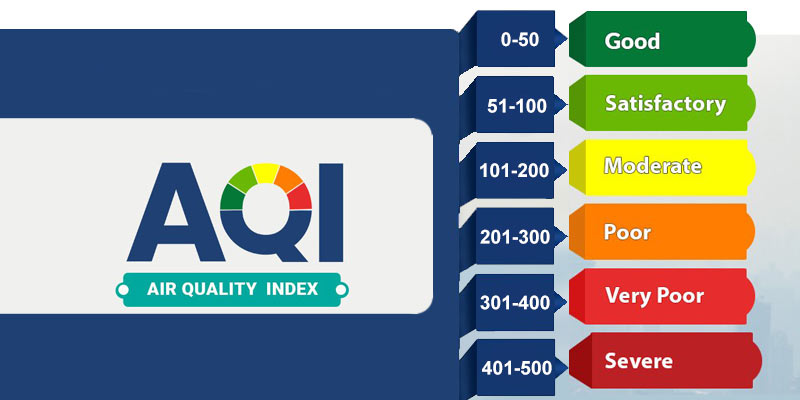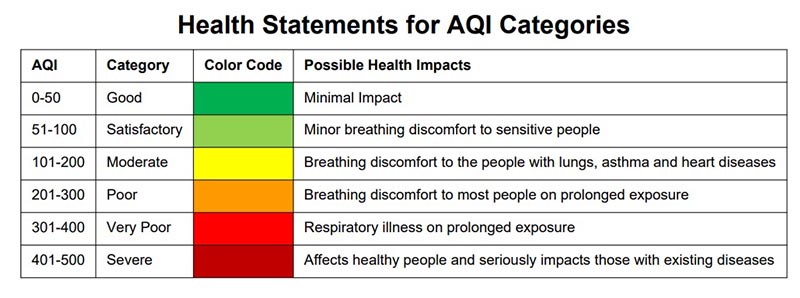- India
- Nov 15
What is Air Quality Index (AQI)?
• The poisonous haze blanketing New Delhi thickened on November 14 with the air quality standing close to the ‘severe’ category amid unfavourable meteorological conditions.
• According to IQAir, a Swiss company that specialises in air quality monitoring, Delhi was the most polluted city in the world on November 14, followed by Dhaka, Lahore and Mumbai.
• New Delhi’s Air Quality Index (AQI) stood at 392 at 8 am. The 24-hour average AQI, recorded at 4 pm every day, was 397 on November 14. It was 358 on November 13 and 218 on November 12.
• Air pollution levels entered the severe category (AQI above 400) at many places within the city.
• Neighbouring Ghaziabad (362), Gurugram (322), Greater Noida (312), Noida (364) and Faridabad (369) also recorded very poor air quality.
The importance of AQI
• With technological advancements, a vast amount of data on ambient air quality is generated and used to establish the quality of air in different areas. The large monitoring data result in volumes of information that neither gives a clear picture to a decision-maker nor to a common man who simply wants to know how good or bad the air is.
• One way to describe air quality is to report the concentrations of all pollutants with acceptable levels (standards). As the number of sampling stations and pollution parameters (and their sampling frequencies) increase, such descriptions of air quality tend to become confusing even for the scientific and technical community.
• Since awareness of daily levels of urban air pollution is important to those who suffer from illnesses caused by exposure to air pollution, the issue of air quality communication should be addressed in an effective manner.
• Further, the success of a nation to improve air quality depends on the support of its citizens who are well-informed about local and national air pollution problems and about the progress of mitigation efforts.
• Addressing these challenges and developing an efficient and comprehensible Air Quality Index (AQI) is required for citizens and policymakers to make decisions to prevent and minimise air pollution exposure and ailments induced from the exposure.
• The concept of AQI was developed and used effectively in many developed countries.
• An air quality index is defined as an overall scheme that transforms the weighed values of individual air pollution related parameters into a single number or set of numbers.
• The objective of an AQI is to quickly disseminate air quality information (almost in real-time) that entails the system to account for pollutants which have short-term impacts.
AQI categories
There are six AQI categories:
i) Good (0–50)
ii) Satisfactory (50-100)
iii) Moderate (101-200)
iv) Poor (201-300)
v) Very Poor (301-400)
vi) Severe (401-500).
The AQI is an assessment of the air quality taking into account eight pollutants — PM 2.5 (particulate matter less than 2.5 microns), PM 10 (particulate matter less than 10 microns), nitrogen oxides (NOx), sulphur dioxide (SO2), ozone (O3), carbon monoxide (CO), ammonia (NH3) and lead (Pb).
Air pollution causes 7 million premature deaths a year
• Every year, exposure to air pollution is estimated to cause 7 million premature deaths and result in the loss of millions more healthy years of life.
• In children, this could include reduced lung growth and function, respiratory infections and aggravated asthma.
• In adults, ischaemic heart disease and stroke are the most common causes of premature death attributable to outdoor air pollution, and evidence is also emerging of other effects such as diabetes and neurodegenerative conditions.
• This puts the burden of disease attributable to air pollution on a par with other major global health risks such as unhealthy diet and tobacco smoking.
• WHO data shows that 9 out of 10 people breathe air that exceeds WHO guideline limits containing high levels of pollutants, with low- and middle-income countries suffering from the highest exposures.
• Air pollution is one of the biggest environmental threats to human health, alongside climate change. Improving air quality can enhance climate change mitigation efforts, while reducing emissions will in turn improve air quality.
• Cities are at the front line for air pollution impacts and interventions. By 2050, almost 68 per cent of the world’s population will be living in cities and breathing urban air. The pace of urbanisation is particularly fast in low and middle-income countries, which brings both challenges from the rapid increase in emissions and opportunities for improving air pollution control through city planning.
• Cities can take action to control key sources of urban pollution such as traffic, industrial activities, waste burning, the burning of solid fuels like coal and wood in homes, and power plants. However, it is important to note that relocation of pollution sources from within the city to the outskirts is often not a viable solution for improving air quality.
Central Pollution Control Board
• The Central Pollution Control Board was constituted as ‘Central Board for the Prevention and Control of Water Pollution’ on September 23, 1974 under the provision of the Water (Prevention & Control of Pollution) Act, 1974.
• Its name was amended as Central Pollution Control Board under the Water (Prevention & Control of Pollution) Amendment Act, 1988.
• The Central Pollution Control Board (CPCB) has been entrusted with the added responsibilities of Air Pollution Control since May, 1981 under the provisions of the Air (Prevention and Control of Pollution) Act, 1981.
• Subsequently, the Environment (Protection) Act, 1986 widened the scope of activities of the Central Board to enforce environmental protection measures through various Rules/ Regulations notified under this Act.
Principal functions of the CPCB are:
i) To promote cleanliness of streams and wells in different areas of the states by prevention, control and abatement of water pollution.
ii) To improve the quality of air and to prevent, control or abate air pollution in the country.
• The CPCB has been continuously playing a key role in prevention and control of pollution in the country by generating, compiling and collating scientific data, providing scientific information, rendering technical inputs for framing national policies/programmes, training/development of manpower and promoting awareness at different levels of stakeholders and public at large.
Manorama Yearbook app is now available on Google Play Store and iOS App Store


